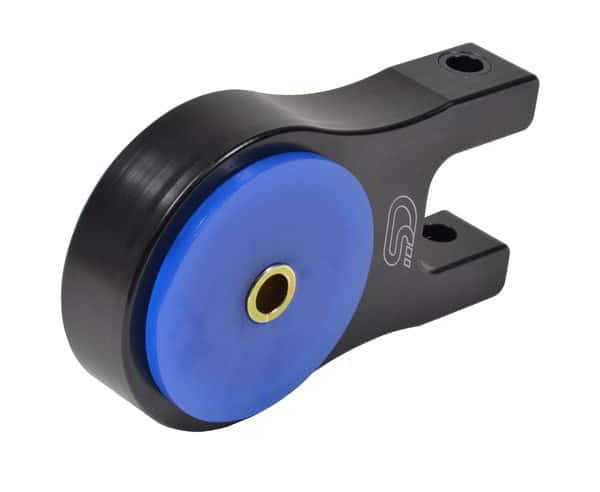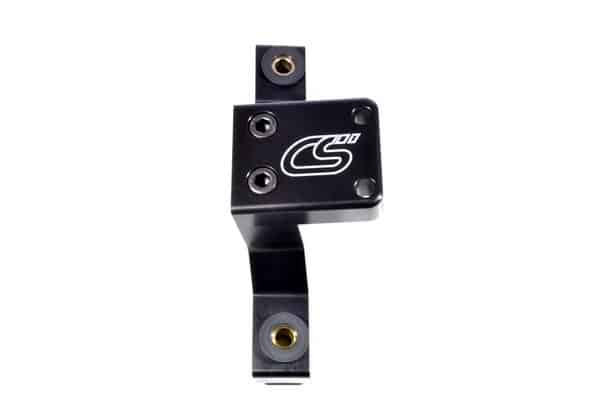What is durometer and what does it mean? If you know what it is, when does it actually matter? Every day at CorkSport we are asked this question. Many times, we are told that many of you assume that the higher the durometer or something attached to a car, the more noise and vibration will be transmitted into the passenger compartment. This however, is not always the case.
Durometer is the measure of the hardness of a material. The higher the number, the harder the material is. When talking about rubber or polyurethane, you will often hear durometer numbers between 60a and 90a. There are several scales for the measurement of durometer, in the case of bushings, you will almost always hear about the Shore A scale. The letter at the end of the rating will tell you which scale you are rating.
When designing engine mounts or suspension pieces, the durometer can be very important, but the shape and how the piece is used can be even more important. The overall durometer number will give you the first idea of how much vibration the mount or bushing might transmit, but this can easily feel different depending on the surface area used.
If you have an engine mount that has to fit a certain area and you decide to design it with a very small bushing, or a bushing that has to do more than just isolate the two parts, you can end up transmitting a lot more vibration. If you compare a 1” diameter bushing and a 2” diameter bushing you don’t end up with double the amount of surface area, you actually increase the surface area by 4 times! That isn’t the only way bushings work though. Depending on the direction of the force, you could use a bushing much smaller and obtain a much better isolation than one with a bigger available surface area subjected to more force. In many cases, only the durometer of the bushing is taken into consideration when many mounts are designed; not how the bushing is used, its size or the forces applied to it.
Recently I was asked by Kevin Pugh (the owner of MazdaSpeed Forum) the durometer of a mount we released. I replied to him; “it doesn’t really matter, but I will tell you anyway”. We had a good laugh and talked about many of these points; and because of that conversation this blog post was born. Much like many of the topics on the CorkSport blog, we recognize the market and what is important to you. This information is as important to you as it is to us, and whether you buy our entire catalog or just read our blog and stay stock, we always want to be of service to the Mazda community that we have been dedicated to since 1998.
Cheers,
Joel




Oooooh if that’s the new aluminum mount for the MS3 I’m glad I opted for that one. Now send it! Lol
Awesome write up as usual moral Joel.
I will have a big review as soon as I get home and install this:)
I agree: less talking, more shipping! Been waiting for the RMM for a while hopefully it will be worth the wait. Glad I upgraded to the machined one, it looks nice!
So when is this going to be available? Im ready to upgrade from my CS rmm inserts as well as the stock passenger and driver side mounts?
I want to get a set of the transmission and passenger motor mount from the same manufacturer. I hope you come out with the full TMM before I shell out for a set. Already have a RMM, is that RMM you have pictured up top a prototype or update from the one you currently offer? Wish I would have known if this was coming out soon. This may sound stupid but the reason I didnt go with your RMM is because of how much it looks like the stock one and the lack of reviews on the forums for it.
All 3 of these mesh together so well!!!!! All of my wheel hop and torque steer is GONE!!! My weak point now is my tires. All of the motor mounts hold the engine and transmission down so well that all the power is focused to the wheels!!!!! If you want to see the before and after of the engine movement. It’s on MSF, under “Dual product release” or on my you tube, my you tube user name is krashfox. If your still just not sure those videos speak for themselves!!!!!!
Have to disagree here. Bushing hardness should be on the higher side for A-arms, sway bar pivots, etc. On one race car, I used lubricated aluminum bushing for the front sway bar pivot, and heim’s for end links. That is stiffer than any polyurethane bushing. And I modified the differential bushings, as the swing axle carried cornering forces against the side of the diff. In that lateral direction, I substituted nylon to take the thrust, but let the oem rubber do the rest, as it was a street car too.
For the MS6 differential, the soft spoked rubber oem mounts allows free motion at light loads and then bottoms out with big forces. With noise from the gears as well as the pulsed diff clutch, noise reduction was a priority. If soft (55-60 dur) full bushings were used at the 3 points of support, with new mounts, you eliminat most of the free motion, but allow some wiggle room to make attachment to the diff casing easier.